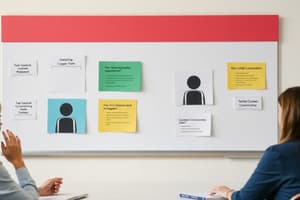Podcast
Questions and Answers
What is the sender in communication?
What is the sender in communication?
Source
What is communication considered to be?
What is communication considered to be?
Process
Which model of communication was proposed by Ellis and McClintock?
Which model of communication was proposed by Ellis and McClintock?
Transaction
Advertising is an example of what type of communication?
Advertising is an example of what type of communication?
What is the oldest media of mass communication?
What is the oldest media of mass communication?
What do we call a set of steps an individual performs to complete a task?
What do we call a set of steps an individual performs to complete a task?
How do order and advice differ?
How do order and advice differ?
What does reprimand serve as an example of?
What does reprimand serve as an example of?
What type of objective does motivation represent in communication?
What type of objective does motivation represent in communication?
What is characterized by committed and cheerful staff?
What is characterized by committed and cheerful staff?
What type of communication is email typically classified as?
What type of communication is email typically classified as?
What does oral communication lack?
What does oral communication lack?
Non-verbal communication is mostly what?
Non-verbal communication is mostly what?
Gestures can be described as what?
Gestures can be described as what?
Who defined communication as the process by which information is transmitted?
Who defined communication as the process by which information is transmitted?
What is the process of converting an idea into symbols called?
What is the process of converting an idea into symbols called?
Which is not a significance of communication?
Which is not a significance of communication?
What does complementary scheme use?
What does complementary scheme use?
What type of communication does a complaint represent?
What type of communication does a complaint represent?
What type of communication is planned and deliberate?
What type of communication is planned and deliberate?
Wherever there are people, what else exists?
Wherever there are people, what else exists?
An open door policy is necessary to improve what type of communication?
An open door policy is necessary to improve what type of communication?
What is communication that flows across the organization among members of the same rank called?
What is communication that flows across the organization among members of the same rank called?
In what year was Morse Code developed by Samuel Morse?
In what year was Morse Code developed by Samuel Morse?
Who invented the telephone?
Who invented the telephone?
When should one use a fax, teleconference, letter, or memo?
When should one use a fax, teleconference, letter, or memo?
Study Notes
Communication Definitions
- Communication is a continuous process.
- Communication is the process by which information is transmitted between individuals and/or organizations so that an understanding response results (Newman).
- Ellis and McClintock have proposed a transaction model of communication.
Communication Types
- Advertising – mass communication
- Grapevine - informal communication
- Email – written communication
Communication Models
- Transaction Model - proposed by Ellis and McClintock
Communication Significance
- Crisis management
- Inspiring team spirit
- Corporate branding
Communication Objectives
- Motivation - primary objective
Communication Process
- Encoding: Converting ideas into symbols.
Communication Channels
- Print media – oldest form of mass communication
- Digital media – modern mass communication
Types of Communication
- Formal communication: Planned and deliberate
- Informal communication: Unscheduled and spontaneous
- Intrapersonal communication: Communication with oneself (e.g., talking to yourself)
- Interpersonal communication: Communication between two people (e.g., a conversation)
- Group communication: Communication between more than two people (e.g., a meeting)
- Mass communication: Communication to a large audience via media (e.g., television, newspapers)
- Downward communication: Information flows from higher levels to lower levels.
- Upward communication: Information flows from lower levels to higher levels.
- Horizontal communication: Information flows among members of same rank.
- Outward communication: Information flows from an organization to the outside world.
- Inward communication: Information flows from the outside world to the organization.
- Verbal communication: Uses spoken words.
- Non-verbal communication: Uses body language, gestures, and facial expressions.
Nonverbal Communication Examples
- Gestures: Culture-specific non-verbal communication.
Communication Trends
- Open door policy – strengthens upward communication
Technology & Communication
- Morse Code: Invented by Samuel Morse in 1838 for telegraphs.
- Telephone: Invented by Alexander Graham Bell.
Communication Methods
- Fax: Provides written record, fast, crosses time zones and countries.
- Teleconference: Useful for multiple parties across locations.
Communication Elements
- Sender: Source of the message
- Receiver: Destination of the message
- Message: Information being communicated
- Channel: Medium used for transmitting message
- Feedback: Response from the receiver
Other Communication Elements
- Salutation: Greeting used in written communications.
- Enclosure: Attachment included with a letter.
- Feedback: Response to a message.
- Procedure: Set of steps for completing a task.
Communication Advice & Persuasion
- Advice: Non-obligatory, often given by laypersons
- Order: Obligatory, given by professionals.
- Reprimand: Used to warn or admonish.
Work Environment
- High morale: Motivated and cheerful staff
Color Schemes in Design
- Complementary: Uses opposite colors on the color wheel.
Studying That Suits You
Use AI to generate personalized quizzes and flashcards to suit your learning preferences.
Related Documents
Description
Explore the various definitions, types, and models of communication in this quiz. Understand the significance and objectives of communication, as well as the different channels used in conveying messages. Challenge your knowledge about formal and informal communication methods.




